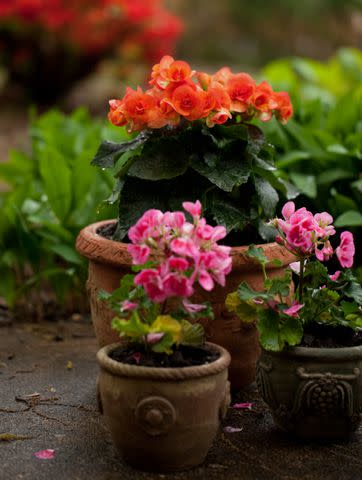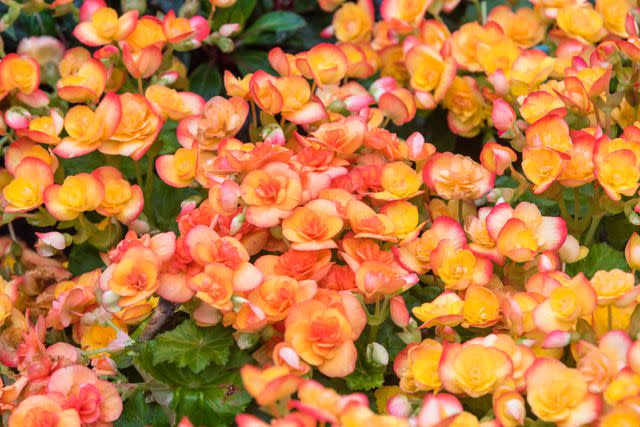Begonias Are a Beautiful Addition to Any Garden—Here’s How to Grow and Care for Them
These long-blooming beauties can bring color to your landscape from summer through fall.
:max_bytes(150000):strip_icc():format(jpeg)/ms-begonias-primary-getty-b0e7156bfd634d508c92c81ec3e41ebc.jpg)
oopoontongoo / Getty Images
Begonias are a beautiful plant hailing from tropical and subtropical climates. There are over 2,000 plant species that are part of the Begoniaceae family. Many people grow begonias for their gorgeous, bright-colored blossoms in a range of hues from white, yellows, and oranges to pinks and reds. Many types also have spectacular foliage.
With so many types of begonias, there's no fast rule on their hardiness—but in warmer climates, they can be grown as perennials, while in colder zones, they can be grown as annuals and/or overwintered. They also make a stunning houseplant—and rank amongst Martha's favorites. (There is even a begonia—Begonia ‘Martha Stewart’—named after her!)
Ahead, we spoke to horticulture experts for tips on growing these classic flowers in your garden—here's what you need to know.
Related: 11 Flowering Plants That Look Beautiful Even When They're Not Blooming
Different Types of Begonias
Before you hit your nursery and start scooping up begonias by the armful, it is helpful to know what types of begonias there are to choose from.
Cane-type: This kind of begonia has many tall stems that look like wood and can resemble bamboo. They have wing-shaped leaves that are pointy and can be shiny or hairy. Occasionally, they are referred to as "angel wing begonias" for their leaf shape. Many produce clusters of flowers in hues of pink, red, and white, blooming from spring to fall.
Hardy: This classification of begonias is lesser known and is part of the B. grandis. Hardy begonias can handle cold weather. These plants do best in moist soil and prefer partial shade.
Rhizomatous: These plants grow from a rhizome, a thick stem below the soil that usually grows horizontally with sprouts emerging. Many begonia species are Rhizomatous, flowering in the winter as they can manage with less light than other begonia species. Most houseplants are also the rhizome variety.
Tuberous: As their name implies, these begonias grow from tubers. Tuberous begonias range in style as some have multiple stems, often with the roots and shoots emerging from the same buds. Many have large-sized flowers that gardeners prize.
Related: Everything You Need to Know About Calandiva, a Beautiful Flowering Succulent
How to Grow Begonias
Begonias are easy to grow—but like most plants, they have their preferences. Here's what they need to grow (and thrive).
Climate
Because these plants grow in tropical and subtropical environments, begonias love humid and warm regions. As perennials, these plants typically do best in warm and hot climates where temperatures are consistently above 60 degrees Fahrenheit outside. In USDA Zones 5 and colder, treat begonias as an annual.
Light
Because there are so many varieties to choose from, each will have different sunlight needs. Some begonias do best in partial sun, while others thrive in full sun. When choosing your variety, check how much light it will need and plant accordingly.

eurobanks / Getty Images
Soil
Begonias need soil that drains well to thrive. Especially if you're planting them in a container to line a porch or patio, pay attention to drainage. "They require a well-draining, airy, soilless potting mix that is not too peat-heavy," says Christina VanWyk, president of the Delaware Valley Branch of the American Begonia Society. "Begonias prefer a neutral to slightly alkaline pH."
Watering
Watering begonias properly is key to their success. These plants do best when the soil is moist. "Begonias prefer evenly moist soil but do not like to sit in water," says Kelly Funk, president of Jackson and Perkins. "Allow the top inch of soil to dry out before watering again."
One of the best ways to know if begonias need water is to check the soil. "To check when to water begonias planted in the ground, simply insert your finger into the top inch of soil," says Autumn Hilliard-Knapp, horticulturist at My Perfect Plants Nursery. "If it's dry, it's probably time to water your plants." In hotter climates, be aware you may need to water more frequently.
Fertilizer
Begonias can benefit from fertilizing, especially when they are growing. "Fertilize during the growing season–spring and summer–with a balanced, water-soluble fertilizer," says Funk.
Jen McDonald, certified organic garden specialist and co-founder of Garden Girls explains how to encourage more blooms. "When begonias are actively growing, you can fertilize once a month with bone meal, which offers a higher phosphorus content," she says. "While nitrogen promotes leafy green growth and contributes to strong plant systems, phosphorus is responsible for more blooms."
You also want to make sure to avoid overfertilizing your begonias as this can lead to root burn adds Funk.
How to Prune Begonias
Many plants need to be pruned to promote growth, keep plants healthy, and maintain their appearance. Begonias, like roses, should be deadheaded. "All varieties of begonias require grooming and pruning for a full compact plant," says VanWyk.
According to Hilliard-Knapp, deadheading begonias is important for optimal growth and development. Pruning keeps the plant thriving and prevents diseases. "It reminds the plant to send energy to new growth and will reward you with increased blooms and a bushier, healthier plant," says McDonald. "It also helps in preventing fungal diseases, as you are removing spent blooms that are likely to rot if left untouched."
Pruning Begonias is easy to do. To deadhead begonias, simply pinch or cut off the dead blooms just above healthy leaves or buds, says Hilliard-Knapp.
Related: The Difference Between Deadheading and Pruning—and How to Use Each for Healthier Plants and Flowers

ChanwitOhm / Getty Images
How to Propagate Begonias
Sometimes, you may want new begonia plants without purchasing seedlings. This can be done with leaf or stem cuttings.
"When choosing a leaf, one should look for a healthy, young but fully grown leaf," says VanWyk. "The easiest and most successful part of the leaf to propagate is where the petiole attaches to the leaf." The petiole is where the base or stalk of the leaf connects to the stem.
Using sharp, sterile scissors or a knife, cut a petiole about 1 inch below the leaf and place it in moist soil. Avoid the leaf touching the soil.
Place the leaf-cutting under bright lights and create high humidity, by placing a plastic container or plastic bag over the pot, says VanWyk. Propagate in an area with a temperature between 68-78 degrees Fahrenheit.
Baby leaves should start appearing at the base of the stem after a few weeks. Once established, you can replant the seedling outdoors or indoors.
Common Problems
Like most garden plants, begonias have their foes—but with knowledge and care, pests and diseases shouldn't be too much of a problem.
Powdery Mildew
A fungal disease, powdery mildew, can plague many outdoor plants, including begonias. Spores are the culprit, spreading by water, wind or insects. Powdery mildew can be prevented with ample air circulation. "To prevent the occurrence of powdery mildew on begonias, it is important to promote good air circulation around the plants," explains Hilliard-Knapp. "This can be achieved by ensuring proper spacing and avoiding overcrowding."
The way you water your begonias can also create a haven for powdery mildew to take over. "Water the plants at the base rather than overhead, as wet foliage can create an environment for the growth of the fungus that causes powdery mildew," says Hilliard-Knapp. If your begonias often get powdery mildew, consider applying a preventative treatment to help minimize this fungal disease. "Use a fungicide as a preventive measure if powdery mildew has been a problem in the past," says Funk.
Root Rot
Root rot is an overall term to describe plants that have a pathogen or fungi that usually thrive in wet soil. "Begonias are very susceptible to root and stem rot," says VanWyk. While root rot is typically associated with container plants, it can happen in the ground, too. Root rot is preventable– don't overwater your begonias, and avoid soggy soil—especially for begonias planted in containers.
Mealybugs
Mealybugs are a common pest that can affect begonias. They are often introduced when you bring a new plant to your landscape. "The best way to prevent mealybugs from entering your collection is to isolate any new plants you bring home," says VanWyk. It's not always easy to tell if a plant has mealybugs, which is why it's crucial plants are separated before incorporating them into your garden. "New plants should be isolated for at least three months, which is the life cycle of the mealybug," she adds.
Different types of mealybugs may feast on your begonias. "Citrus mealybugs are the common mealy that one will see scurrying around on the stems and leaves of a plant," explains VanWyk. "There are several stages to their life cycle, including the egg and nymph stages that are commonly found around the crown of the plant at or below the soil line."
Another kind of mealybug is often hidden in the roots, making it more difficult to find. "Root mealybug lives around the rootball of a plant and can only be seen when the plant is taken out of a pot and the roots exposed," says VanWyk.
If you find mealybugs on your begonias, there are ways to treat them. "Simply dip a Q-tip into 70 percent rubbing alcohol and dab it directly onto the mealybug to kill it, then remove from the leaf," says VanWyk. "Make sure to inspect the entire plant, including the roots." Another option for managing mealybugs is by bringing in other insects to eliminate these pests. "A preventative integrated pest management (IPM) rotation of beneficial insects can also be crucial in eliminating harmful pests we may have missed when inspecting the new plants we have brought home," she says.
Spider Mites
Spider mites are another frequent pest that can negatively impact your begonias. Checking the leaves often is key to detecting them. "Spider mites can be controlled with regular inspection of leaves," says McDonald. "They often prefer to hide in masses on the undersides of tender leaves." Once you find spider mites, there are a few methods to get rid of them. One is spraying the leaves with a garden hose in the morning so there's enough time for the leaves to dry by the evening. "Gently spray the begonia with water, paying close attention to the undersides of leaves where the mites often reside," says Hilliard-Knapp.
Another option is removing the leaves that have a significant spider mite population. "By removing the infested foliage, you can help prevent the mites from spreading to other parts of the plant," she says. If you choose to remove leaves, McDonald advises, "Just remember to never remove more than one-third of a plant at one time, or you’ll send it into shock."
Read the original article on Martha Stewart.

